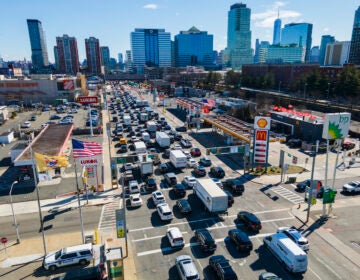Explainer: Taking the mystery out of hurricanes that hit New Jersey

While New Jersey may not be as vulnerable as Florida, the Carolinas, or the Gulf Coast, the destruction caused by Sandy nearly three years ago was a forceful reminder that the Garden State is by no means immune from powerful storms. In fact, the state Office of Emergency Management notes that more than 70 tropical storms have come within 65 nautical miles of the Jersey Shore over the past 150 years.
The Atlantic hurricane season typically runs from June to November, but with most activity beginning right around this time — from late August through September — here’s a look at the history of storms in the state, how they occur, and what the outlook is for the future.
How hurricanes work
In her book Superstorm: Nine Days Inside Hurricane Sandy, Kathryn Miles writes that a hurricane is simply “a formidable collection of dozens of fierce thunderstorms swirling together.” But its destructive power is magnitudes greater than the sum of its parts. “Minute for minute, a single storm can exceed the energy produced by all the world’s power plants — five times over,” she says, noting that over the course of its life, a typical hurricane will generate as much energy as 10 thousand atomic blasts.
North Atlantic hurricanes originate in the warm, equatorial waters between western Africa and the Gulf of Mexico. Just like their cousins called “typhoons” or “cyclones” in the Pacific and Indian Oceans, hurricanes are tropical cyclones with sustained winds of more than 74 miles per hour.
Determining a storm’s destructive potential
Once a storm is officially declared a hurricane, it’s classified by its severity, with storms exhibiting winds of more than 111 miles per hour (Category 3 and above) considered the most dangerous. Wind speed isn’t the only important factor to consider. After all, meteorologists warn that the greatest threat to life and property posed by hurricanes is not from the wind, but from storm surge along the coast. Part of the reason Sandy caused as much damage as it did to the Garden State — despite weakening from a hurricane to a post-tropical cyclone before making landfall — is that it hit at high tide, when the coastline was most vulnerable to flooding.
Another common misperception is that the people most in danger are those living directly in the path of the eye of the storm. Since hurricanes rotate in a counter-clockwise direction north of the equator, the reality is that those living along the coast north of the eye are actually at the greatest risk. This was certainly the case during Sandy, which made landfall at Brigantine. Areas to the south like Cape May and the Wildwoods sustained relatively little damage, while more northern towns like Mantoloking and Union Beach were devastated.
It’s also worth noting that hurricanes aren’t the only type of destructive storm that pose a threat to New Jersey. In fact, prior to Sandy, one of the most powerful storms in recent memory was the infamous Ash Wednesday nor’easter of 1962, which damaged or severely destroyed some 45,000 homes in the state. Unlike hurricanes that feed on warm and humid air in the tropics, nor’easters form within 100 miles of the East Coast before traveling inland.
History of hurricanes in New Jersey
Historically, the cooler waters off the Jersey Shore have had the effect of weakening hurricanes as they made their way up the Eastern Seaboard. Still, the state’s Hazard Mitigation Plan notes that a number of serious storms have affected the region over the years. Often, New Jersey is threatened by remnants of larger storms that hit the Gulf or Atlantic coast hundreds of miles south but still maintain sufficient wind and precipitation to cause substantial damage to the state.
“Because of its northern location on the Atlantic coastline, direct hits by storms of hurricane strength have a relatively low probability of impacting New Jersey,” the plan says. But the threat remains, especially to portions of eight counties and 126 municipalities along the state’s 127 miles of ocean coastline. In some cases, inland areas along tidal rivers are also vulnerable. This was the case with Hurricane Floyd in 1999, which caused $250 million in damage and record flooding along the Millstone River in Manville and the Raritan River in Bound Brook.
Quiet storm season
The 2015 Atlantic Hurricane Season started earlier than usual, with Tropical Storm Ana making landfall in South Carolina in early May. Since then, however, it’s been fairly quiet — producing about half as many storms as in an average year — due to avariety of climatological factors caused by an El Niño warming pattern over the Pacific. Atlantic Ocean surface temperatures are several degrees colder than average, and there’s an increased amount of dust blowing from the Sahara desert. In addition, a high-pressure system over the Atlantic and stronger winds in the upper atmosphere have not been conducive to storm formation. Some scientists predict that this period of relative inactivity could continue for some time to come, if historical fluctuations in sea surface temperature are any indication of what lies ahead.
Future forecasts
In the aftermath of Sandy, many pundits pondered whether the storm had been “caused” by climate change, but that’s the wrong question to ask, experts say. Weather and climate are complicated phenomena influenced by a multitude of factors, with much of the scientific knowledge concerning them continuing to evolve. Therefore, it’s impossible to give definitive, black-and-white answers about the potential impacts of various climatological events. The reality is more nuanced.
Rather than attempting to draw a direct, causal relationship, scientists think that anthropogenic factors like rising sea levels and warmer temperatures at the ocean’s surface may enhance the destructive power of storms like Sandy that might have occurred anyway.
Localized climatological forecasts for New Jersey are uncertain, but on a global level, the current consensus is that the future occurrence of hurricanes will essentially remain the same or may even decrease over time. That said, the science suggests that those hurricanes that do occur will probably increase in strength and could bring with them greater amounts of precipitation.
Above all, when taking global warming and climate change into account, scientists are quick to warn that we’re entering a new era unlike the past, so historical trends are a poor indication of what’s likely to occur in the future.
_____________________________________________________
NJ Spotlight, an independent online news service on issues critical to New Jersey, makes its in-depth reporting available to NewsWorks.
WHYY is your source for fact-based, in-depth journalism and information. As a nonprofit organization, we rely on financial support from readers like you. Please give today.




